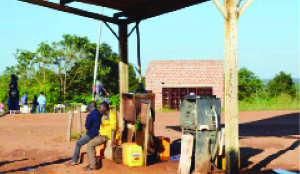By Austin Kaluba –
While the two districts, Mwinilunga and Ikeleng’i are usually type cast as sources of pineapples, they are also melting pots of traders who come from as far as Angola, Tanzania and Congo DR.
At Mwinilunga town centre, one hears a babel of languages though its ci-Lunda that dominates. Greetings of Shikenu Mwane-(how are you?)-fill the air as locals greet each other.
A motor bike ridden by a youth wearing a Manchester United T-shirt would zoom by leaving the smell of fuel in the air.
The district has more motor bikes than motor vehicles which are bought cheaply from the neighbouring Angolan border.
I saw a trader selling pineapples at the town centre while chatting to a beautiful girl with silky black hair and pearly white teeth.
From time to time, the young man would lovingly pat the girl on her back. The girl who was selling scones would shrug off the pat mischievously and tantalisingly.
At a nearby Christian Mission In Many Lands (CMML), a dominant church in North-Western Province, the faithful are coming out of church and chatting excitedly.
Some ride off their bicycles while a few get on their motor bikes.
At the nearby Mwinilunga District new market, business of all sorts thrive; foodstuffs, groceries, second hand clothes, hardware and restaurateurs known as kontama-nshima cooks, go about their business.
The market master John Ndumba Samalowa, an old dark man with greying hair takes me into his office and explains the genesis of this bustling commercial hub.
“This market was opened in 1996 and has 142 stalls. However, there are now too many people selling at the market. We are calling on the Government to build more stalls or even a new market,’’ he says.
Mr Samalowa proudly says there is harmony despite the myriad of tribes and nationalities that trade at the market.
He says local traders mainly comprise the local Lundas, Luvales, Lozis and Kaondes. The foreigners include Congolese who sell salaula and Tanzanians who trade in shoes.
Since the foreigners are pedestrian traders, there is no apprehension from the locals who know that they will finally go back to their countries after business.
Mr Samalowa also complained of poor sanitation at the market because of the large number of human traffic.
The market is dominated by womenfolk who sell mostly foodstuffs. Mr Samalowa said only two male marketeers sell food there.
Two marketeers Elezina Kapiha and Tomaida Simonda have been selling Kapenta-(dried herrings) since the market opened.
Near the market, is Muchima filling station, an open air filling point where a filling station used to be. Now what remains of the facility are two derelict British pumps.
Here youths patiently wait with yellow containers to sell diesel and petrol to passing motorists and motor bikes.
Taking advantage of the number of motor bikes, one enterprising youth Chrispin Luzendi has opened an open air garage where he repairs these vehicles.
The motor bikes bear names like Bajaji, Tite or Rapid, the latter which is a clutchless bike, just needs starting and off it goes.
A good second hand motor bike costs K2,500 or can even be exchanged with ten to 15 goats.
In the newly-created district of Ikeleng’i, the local market is bustling with business as traders jostle with each other to sell a variety of wares.
Dozens of tiny shops and ramshackle structures announced as ‘stores’ or ‘shops’ are dotted around the district centre.
The names of the stalls showcase a sense of survival, tribal inclination and a deep-seated spirituality.
These include ‘Shikenu Mwane- Chakufuma Kuluwi’, ‘Help Me Grow’, ‘Yesu Kristu Diyi Mwanta-Jesus Christ is the Lord’, ‘Masulwila Eyala’ and ‘The Lord is My Shepherd’.
Ikeleng’i market was built in 2004 through a ZAMSIF initiative and unlike Mwinilung’a District the new market is beset by more serious problems.
Gadic Kaumba, a baker at the market said the major problem is transporting goods to the district whose rivers are flooded in the rainy season making them difficult to cross.
Mr Kaumba whose bakery is quaintly named ‘Shokoto’-meaning overcoming problems is not happy with what he calls slow pace of development in Ikeleng’i.
‘While we appreciate the creation of Ikeleng’i as a district we are dismayed at the slow pace of development. There are so many things that need to be done for Ikeleng’i to qualify as a district.
His colleague Alpha Banda, an office orderly at the District Education Board (DEBS) who was whiling time in the stall agrees complaining that, the Government needs to hasten development in Ikeleng’i.
Despite the complaints of some residents, Ikeleng’i is quickly shaping up into a district complete with a modern market, secondary schools and several churches.
Though evidence of Westernisation is celarly visible, the two districts, Mwinilunga and Ikeleng’i still retain their cultural identity.
The Lundas unlike other tribes in Zambia, have more traditional ceremonies, the prominent ones being ‘Chisemwa cha Lunda’, ‘Lunda Lubanza’ and ‘Chidika cha Mvula’.
Like Luvales, Lunda boys and girls undergo the Mukanda and Nkang’a initiation ceremonies respectively.
The locals in the two districts have taken advantage of the area’s proximity to Angola and Congo DR with which they trade in an assortment of goods.
This has provided an alternative greatly stemming urban migration. The most desperately disappointed job-seeker can got to town to seek employment-but it remains a last resort.
Today, Ikeleng’i seems to have edged Mwinilunga as a district defined by pineapple production and is proud of the distinction.
This can be seen from the poster that greets visitors, which reads: : “Welcome to Ikeleng’i District, the home of the source of the Zambezi River and Pineapples”.







